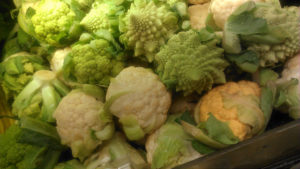
Cruciferous vegetables belong to the family Cruciferae (also known as Brassicaceae). Many of the most common cruciferous vegetables in people’s diets come from the Brassica genus, although many other in different genera are also edible.
They are cool weather vegetables and have flowers that have four petals so that they resemble a cross.
Here is a list of the most common brassicas (for a more comprehensive list, click here):
- Broccoli
- Brussel sprouts
- Cabbage
- Cauliflower
- Collards
- Kale
- Kohlrabi
- Mustard
- Turnip
- Watercress
How do cruciferous vegetables relate to our microbiota?
These vegs contain high levels of glucosinolates as well as enzimes called myrosinases. When you eat raw broccoli, its myrosinases convert the glucosinolates into isothiocyanates (ITC). When you cook it, however, the myrosinases are inactivated by heat.
Some research has shown that ITCs have anti-cancer properties, especially against colorectal, lung, breast and prostate cancers. As the myrosinases are lost during the cooking process, does it mean you must always eat your cruciferous raw to benefit from their cancer protective effects?
Here is where our gut bacteria come to the rescue.
Research has shown that some bacteria produce thioglucosidases. This compound acts as the veg’s myrosinases, converting glucosinolates into ITCs. So, as long as you have bacteria producing thioglucosidases, and we all do to some extent, you will benefit from eating cooked cruciferous vegetables.
It is worth noting that some studies have shown significant differences in production of ITCs between individuals, suggesting differences in activity or composition of the gut bacteria involved in the process. This means that some people may have more of these bacteria than others, or that their bacteria are more efficient in producing ITCs.